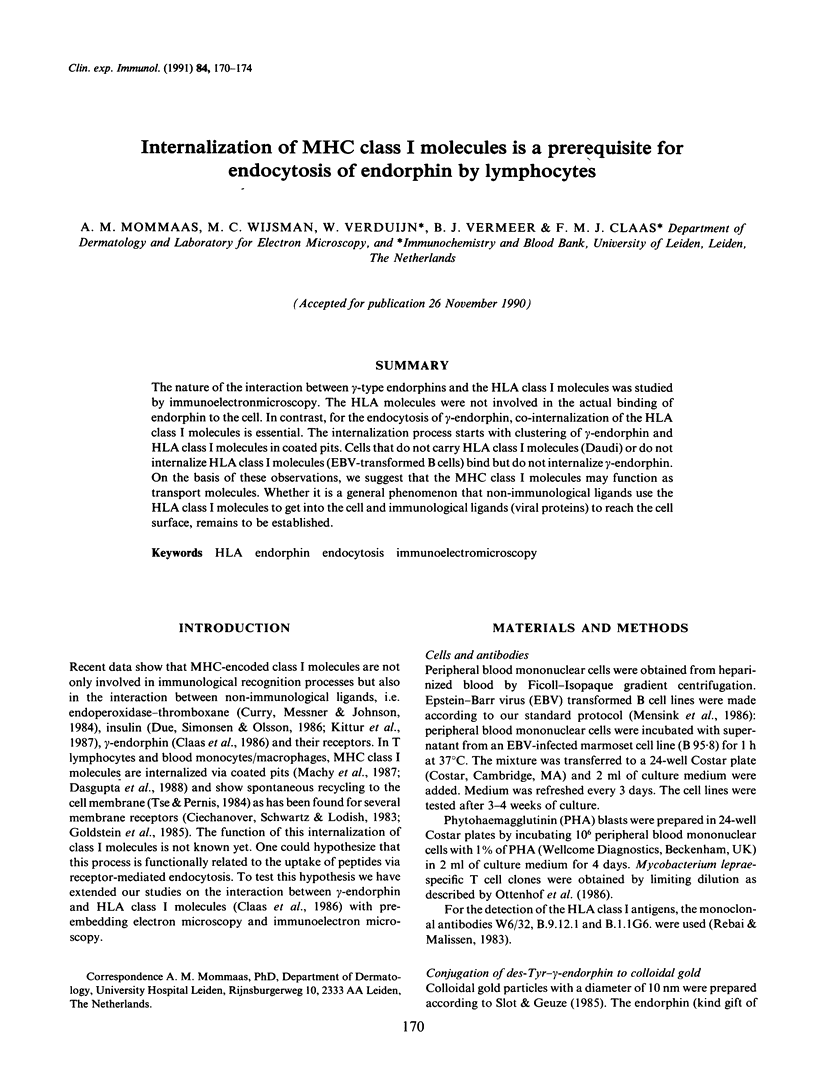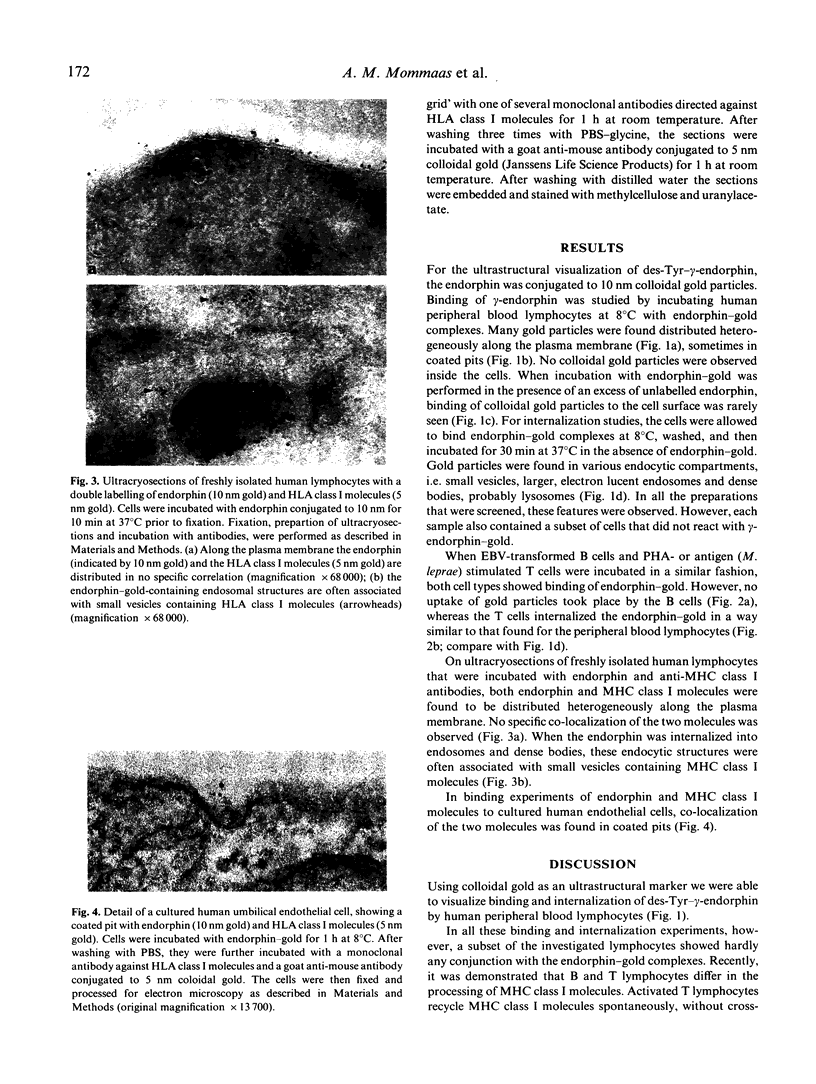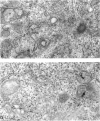Abstract
The nature of the interaction between gamma-type endorphins and the HLA class I molecules was studied by immunoelectronmicroscopy. The HLA molecules were not involved in the actual binding of endorphin to the cell. In contrast, for the endocytosis of gamma-endorphin, co-internalization of the HLA class I molecules is essential. The internalization process starts with clustering of gamma-endorphin and HLA class I molecules in coated pits. Cells that do not carry HLA class I molecules (Daudi) or do not internalize HLA class I molecules (EBV-transformed B cells) bind but do not internalize gamma-endorphin. On the basis of these observations, we suggest that the MHC class I molecules may function as transport molecules. Whether it is a general phenomenon that non-immunological ligands use the HLA class I molecules to get into the cell and immunological ligands (viral proteins) to reach the cell surface, remains to be established.
Full text
PDF




Images in this article
Selected References
These references are in PubMed. This may not be the complete list of references from this article.
- Anderson R. G., Brown M. S., Beisiegel U., Goldstein J. L. Surface distribution and recycling of the low density lipoprotein receptor as visualized with antireceptor antibodies. J Cell Biol. 1982 Jun;93(3):523–531. doi: 10.1083/jcb.93.3.523. [DOI] [PMC free article] [PubMed] [Google Scholar]
- Ciechanover A., Schwartz A. L., Lodish H. F. The asialoglycoprotein receptor internalizes and recycles independently of the transferrin and insulin receptors. Cell. 1983 Jan;32(1):267–275. doi: 10.1016/0092-8674(83)90517-2. [DOI] [PubMed] [Google Scholar]
- Claas F. H., van Ree J. M., Verhoeven W. M., van der Poel J. J., Verduyn W., de Wied D., van Rood J. J. The interaction between gamma-type endorphins and HLA class I antigens. Hum Immunol. 1986 Apr;15(4):347–356. doi: 10.1016/0198-8859(86)90011-x. [DOI] [PubMed] [Google Scholar]
- Curry R. A., Messner R. P., Johnson G. J. Inhibition of platelet aggregation by monoclonal antibody reactive with beta 2-microglobulin chain of HLA complex. Science. 1984 May 4;224(4648):509–511. doi: 10.1126/science.6324346. [DOI] [PubMed] [Google Scholar]
- Dasgupta J. D., Watkins S., Slayter H., Yunis E. J. Receptor-like nature of class I HLA: endocytosis via coated pits. J Immunol. 1988 Oct 15;141(8):2577–2580. [PubMed] [Google Scholar]
- Due C., Simonsen M., Olsson L. The major histocompatibility complex class I heavy chain as a structural subunit of the human cell membrane insulin receptor: implications for the range of biological functions of histocompatibility antigens. Proc Natl Acad Sci U S A. 1986 Aug;83(16):6007–6011. doi: 10.1073/pnas.83.16.6007. [DOI] [PMC free article] [PubMed] [Google Scholar]
- Geuze H. J., Slot J. W., Strous G. J., Lodish H. F., Schwartz A. L. Intracellular site of asialoglycoprotein receptor-ligand uncoupling: double-label immunoelectron microscopy during receptor-mediated endocytosis. Cell. 1983 Jan;32(1):277–287. doi: 10.1016/0092-8674(83)90518-4. [DOI] [PubMed] [Google Scholar]
- Goldstein J. L., Brown M. S., Anderson R. G., Russell D. W., Schneider W. J. Receptor-mediated endocytosis: concepts emerging from the LDL receptor system. Annu Rev Cell Biol. 1985;1:1–39. doi: 10.1146/annurev.cb.01.110185.000245. [DOI] [PubMed] [Google Scholar]
- Kittur D., Shimizu Y., DeMars R., Edidin M. Insulin binding to human B lymphoblasts is a function of HLA haplotype. Proc Natl Acad Sci U S A. 1987 Mar;84(5):1351–1355. doi: 10.1073/pnas.84.5.1351. [DOI] [PMC free article] [PubMed] [Google Scholar]
- Machy P., Truneh A., Gennaro D., Hoffstein S. Major histocompatibility complex class I molecules internalized via coated pits in T lymphocytes. Nature. 1987 Aug 20;328(6132):724–726. doi: 10.1038/328724a0. [DOI] [PubMed] [Google Scholar]
- Mensink E. J., Schuurman R. K., Schot J. D., Thompson A., Alt F. W. Immunoglobulin heavy chain gene rearrangements in X-linked agammaglobulinemia. Eur J Immunol. 1986 Aug;16(8):963–967. doi: 10.1002/eji.1830160815. [DOI] [PubMed] [Google Scholar]
- Mommaas-Kienhuis A. M., Krijbolder L. H., Van Hinsbergh V. W., Daems W. T., Vermeer B. J. Visualization of binding and receptor-mediated uptake of low density lipoproteins by human endothelial cells. Eur J Cell Biol. 1985 Mar;36(2):201–208. [PubMed] [Google Scholar]
- Ottenhoff T. H., Klatser P. R., Ivanyi J., Elferink D. G., de Wit M. Y., de Vries R. R. Mycobacterium leprae-specific protein antigens defined by cloned human helper T cells. Nature. 1986 Jan 2;319(6048):66–68. doi: 10.1038/319066a0. [DOI] [PubMed] [Google Scholar]
- Rebaï N., Malissen B. Structural and genetic analyses of HLA class I molecules using monoclonal xenoantibodies. Tissue Antigens. 1983 Aug;22(2):107–117. doi: 10.1111/j.1399-0039.1983.tb01176.x. [DOI] [PubMed] [Google Scholar]
- Slot J. W., Geuze H. J. A new method of preparing gold probes for multiple-labeling cytochemistry. Eur J Cell Biol. 1985 Jul;38(1):87–93. [PubMed] [Google Scholar]
- Tokuyasu K. T. A technique for ultracryotomy of cell suspensions and tissues. J Cell Biol. 1973 May;57(2):551–565. doi: 10.1083/jcb.57.2.551. [DOI] [PMC free article] [PubMed] [Google Scholar]
- Tse D. B., Pernis B. Spontaneous internalization of Class I major histocompatibility complex molecules in T lymphoid cells. J Exp Med. 1984 Jan 1;159(1):193–207. doi: 10.1084/jem.159.1.193. [DOI] [PMC free article] [PubMed] [Google Scholar]






